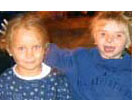April 10, 2006
Share and Share Alike
EDITOR'S NOTE: A story in the April 4 New York Times points out the problems non-disabled sibling have when there's a disabled kid in the family. But there's another side to that story:
My children, Nell and Jake, share a great deal, like many young brothers and sisters do. They wear each other's jeans and sweatshirts. They like to watch Spongebob Squarepants together after school. They go trick-or-treating together, they go swimming together, they go to the playground together. At Costco, they sit in two-seater carts together, side-by-side. They both have pale hair and eyes, and a love of chocolate cake (mashed for Jake, extra icing for Nell).
 Because they share so much, they also share in the benefits of access and inclusion. Sometimes this is a very obvious, concrete benefit: we can go more places as a family when accessibility is good. Our favorite playground, Aidan's Place near UCLA, is a great place for both kids, full of new and creative play equipment, forgiving surfaces, and a diverse clientele from across the city. There are sand basins at chair height for Jake, and swings that both children can use safely. Hospitals that have good child-life programs for pediatric patients tend to also meet the bedside siblings' needs--so Nell can give detailed reviews of the playrooms and video collections at three Los Angeles-area hospitals.
Because they share so much, they also share in the benefits of access and inclusion. Sometimes this is a very obvious, concrete benefit: we can go more places as a family when accessibility is good. Our favorite playground, Aidan's Place near UCLA, is a great place for both kids, full of new and creative play equipment, forgiving surfaces, and a diverse clientele from across the city. There are sand basins at chair height for Jake, and swings that both children can use safely. Hospitals that have good child-life programs for pediatric patients tend to also meet the bedside siblings' needs--so Nell can give detailed reviews of the playrooms and video collections at three Los Angeles-area hospitals.
Sometimes, the shared benefit is more intangible, but no less real. Where Jake is included, where he's recognized and valued as a person, Nell gets a message too: your family is within the realm of the ordinary; your love is well-placed. When we are part of a diverse community of families, she has built-in peer support--no special meetings required, her everyday friends already "get it." When she sees characters using wheelchairs on Sesame Street, or watches the happy kids on Signing Time videos, she is reassured: this is what "normal" looks like, sometimes.
Just as both kids benefit from good access and inclusion, bad access hurts both kids. Nell, at six, is too young to understand a lot of the complicated ways that Jake is excluded, but she's certainly aware that Jake isn't allowed into the supervised playroom at IKEA (because diapers are forbidden). She wishes they attended school together (and more importantly, that they rode the bus together); she wishes it was easier to take him to her favorite beach. She'll speak up when Jake needs an advocate: at age three, she tugged a nurse's scrubs to explain, "Jake doesn't likes x-rays," and "Jake doesn't says words."
My son Jake was born with his rare chromosome disorder in 1995, two decades after the IDEA, and four years after the ADA was signed. He has benefited from the generations before him that fought for access, that demanded rights, that designed equipment and wrote storybooks with him in mind. Some of those fighters and writers were siblings, and I would love for them to know that, whether or not they intended it, their work is now reaching and shaping siblings in a new century, too. The justice they dreamed, Nell simply expects. The words they chose may well be the words she uses to express her love with honesty and pride.
Someday, we'll teach Nell about that legacy. Disability history can be her history, too. She should know that she shares a sibling's experience with Walt Whitman and Margaret Fuller, among others. But kids don't need famous names to learn. In fact, it's the seemingly routine stuff that has the biggest impact. Curb cuts in our street corners may be convenient for Nell's Barbie scooter, but they also bear daily witness to a commitment, carved in concrete, to be a community that includes her brother.
Anything that makes the world a more welcoming place for Jake, anything that embraces him as a person, as a citizen, as a child, makes life better for his sister, too. That's been our sibling experience.
Penny Richards is a research scholar affiliated with UCLA's Center for the Study of Women. She co-edits H-Disability and is on the blog team at Disability Studies, Temple U.
Posted on April 10, 2006